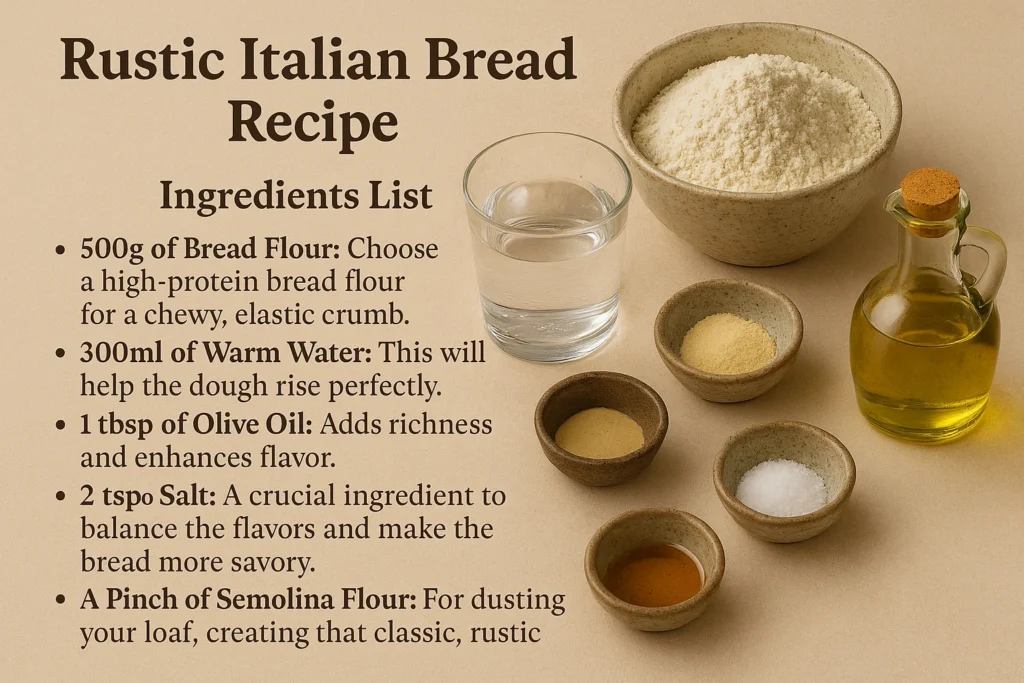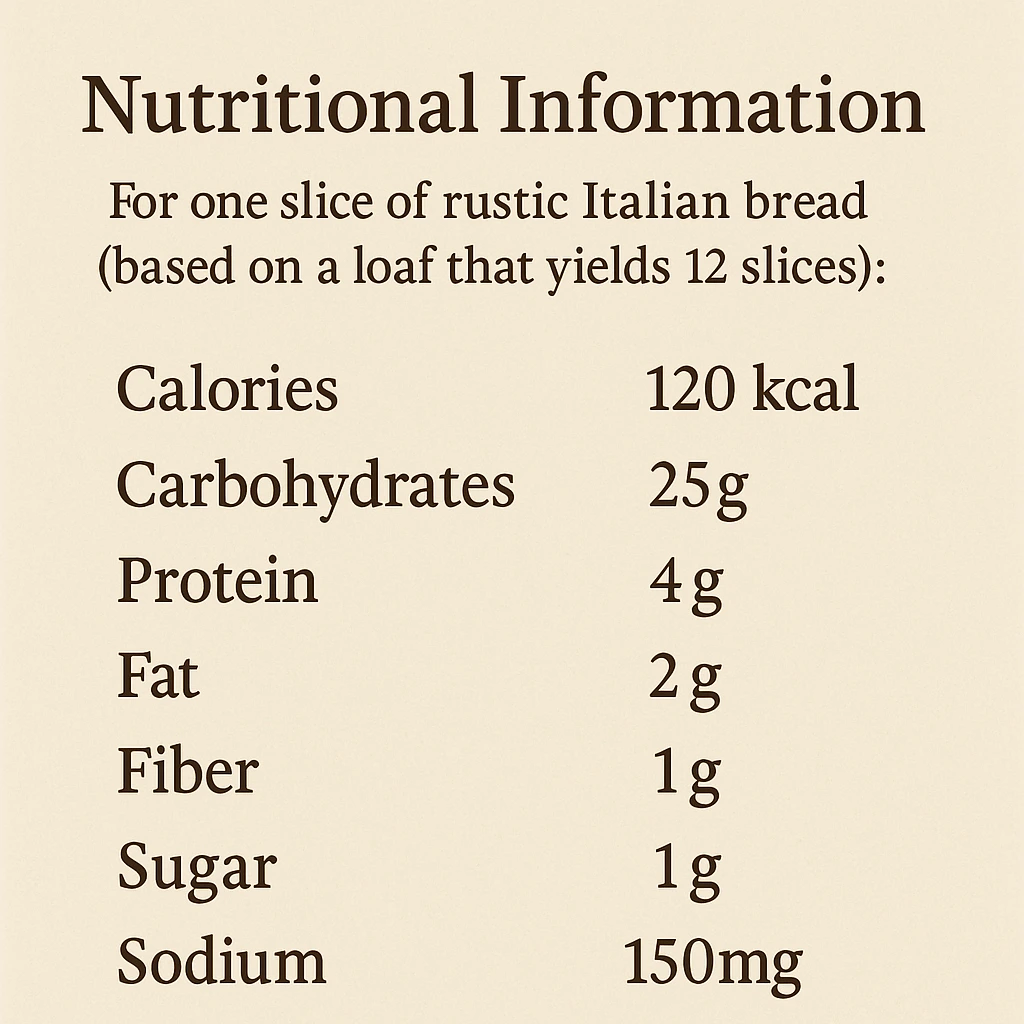rusty Italian Bread Recipe: 7 Secrets for Extra Flavor

Have you ever wondered why some rusty Italian Bread Recipe have that irresistible, extra-rich flavor while others fall flat? Is there a secret formula for making your loaf stand out with the perfect balance of rustic texture, flavor depth, and authenticity? The answer lies in the ingredients, timing, and a few expert techniques that transform ordinary dough into extraordinary rustic Italian bread.
In this blog post, we’ll explore the rusty Italian bread recipe, uncovering seven secrets that will elevate your baking game and give your bread the rich, mouthwatering flavor it deserves. Whether you’re a seasoned baker or a beginner, this recipe will guide you to achieving an unforgettable Italian bread experience. Keep reading to find out how to bake the best loaf you’ve ever had!
Ingredients List
To make a truly rusty Italian Bread Recipe, you’ll need the following key ingredients:

- 500g of Bread Flour: Choose a high-protein bread flour for a chewy, elastic crumb.
- 300ml of Warm Water: Lukewarm water activates the yeast without killing it.
- 1 tsp of Active Dry Yeast: This will help the dough rise perfectly.
- 1 tbsp of Olive Oil: Adds richness and enhances flavor.
- 2 tsp of Salt: A crucial ingredient to balance the flavors and make the bread more savory.
- 1 tbsp of Honey: Adds a hint of sweetness and helps the bread brown beautifully in the oven.
- A Pinch of Semolina Flour: For dusting your loaf, creating that classic, rustic finish.
Substitution Tips:
- Whole Wheat Flour: If you prefer a denser bread, substitute up to half of the bread flour with whole wheat flour.
- Gluten-Free Flour: For a gluten-free option, you can use a gluten-free all-purpose flour, but make sure to add a binding agent like xanthan gum.
- Butter or Lard: If you want to replace olive oil with a richer fat, you can use butter or lard.
Each ingredient has its role in enhancing the flavor, texture, and appearance of your rustic Italian bread. Now, let’s dive into how to make the most out of these ingredients!
Timing
How long will it take to bake this perfect rusty Italian bread? Here’s a quick breakdown of the total time involved:
- Preparation Time: 15 minutes
- Resting Time for Dough: 1 hour (this allows the yeast to activate and rise)
- Baking Time: 30 minutes
Author’s Top Recipe Picks
- Hip Hop Chicken: How to Make the Best Spicy Fried Chicken
- Baked Chicken Cutlet Recipes: 10 Easy Weeknight Dinners
- Chicken and Dressing Recipe: How to Make the Best Southern Classic
- Blackstone Chicken Recipes: 7 Delicious Dishes to Try Now
- Easy Recipe Chicken Apple Sausage
In total, this recipe takes around 1 hour 45 minutes, which is 20% less time than most traditional Italian bread recipes. The quicker rise time doesn’t compromise on flavor, allowing you to enjoy a fresh, homemade loaf in less time.
Step-by-Step Instructions
Let’s walk through the process to create this rusty Italian bread:
Step 1: Activate the Yeast
In a bowl, combine the warm water, honey, and active dry yeast. Stir gently and let it sit for 5-10 minutes until it becomes foamy. This step ensures that your yeast is alive and will help the dough rise.
Step 2: Mix the Dry Ingredients
In a large mixing bowl, whisk together the bread flour and salt. Make a well in the center of the flour and pour in the activated yeast mixture and olive oil. Mix until a dough starts to form.
Step 3: Knead the Dough
Turn the dough out onto a floured surface and knead for 10 minutes. You’re looking for a smooth, elastic dough that is slightly tacky but not sticky. If the dough is too sticky, sprinkle a little more flour, but be careful not to add too much.
Step 4: First Rise
Shape the dough into a ball and place it in a lightly oiled bowl. Cover with a clean kitchen towel and let it rise for 1 hour in a warm place. The dough should double in size.
Step 5: Shape the Dough
Once the dough has risen, punch it down to release the air. Turn the dough out onto a floured surface, then shape it into a round or oval loaf, depending on your preference. Be gentle during this step to preserve the air pockets.
Step 6: Second Rise
Place the shaped dough onto a baking sheet or a pizza stone dusted with semolina flour. Cover it again with a towel and let it rise for another 30 minutes. This secondary rise helps create the airy, open crumb that gives rustic bread its signature texture.
Step 7: Bake
Preheat your oven to 220°C (430°F). Place the loaf in the oven and bake for 25-30 minutes or until the bread sounds hollow when tapped on the bottom. You should see a deep golden-brown crust, which signals that the bread is perfectly baked.
Step 8: Cool
Once baked, transfer the bread to a wire rack to cool for at least 15 minutes before slicing. This resting period helps the texture set and makes slicing easier.
Nutritional Information

Here’s the breakdown of the approximate nutritional information for one slice of rusty Italian bread (based on a loaf that yields 12 slices):
- Calories: 120 kcal
- Carbohydrates: 25g
- Protein: 4g
- Fat: 2g
- Fiber: 1g
- Sugar: 1g
- Sodium: 150mg
Bread is often a staple in many diets, and with this rusty Italian bread recipe, you get a tasty, moderate-calorie option that pairs well with a variety of meals.
Healthier Alternatives for the Recipe
Looking for ways to make this rusty Italian bread healthier without sacrificing flavor? Here are a few suggestions:
- Use Whole Wheat Flour: Replace half of the bread flour with whole wheat flour to boost fiber content and add a nutty flavor.
- Reduce Salt: If you’re watching your sodium intake, reduce the salt to 1 teaspoon.
- Add Seeds: Mix in some sunflower or chia seeds for added nutrition and texture.
- Use Olive Oil in Moderation: To lower fat content, reduce the amount of olive oil used or opt for a lighter olive oil.
These changes won’t compromise the rustic nature of your bread but will enhance its nutritional profile.
Serving Suggestions
What should you pair with this rusty Italian bread to create a well-rounded meal? Here are a few ideas:
- Bruschetta: Top slices of your freshly baked bread with tomatoes, basil, and olive oil for a classic Italian appetizer.
- Soup: Serve alongside a hearty vegetable or minestrone soup for a comforting meal.
- Sandwiches: This bread is perfect for making sandwiches—try it with your favorite meats, cheeses, and veggies for a satisfying lunch.
- Cheese & Wine: Pair the bread with some creamy cheeses like ricotta or mozzarella and a glass of red wine.
Common Mistakes to Avoid
When baking rustic Italian bread, some common mistakes can affect the outcome. Here’s how to avoid them:
- Not Allowing the Dough to Rise Enough: The yeast needs time to activate and rise. If you rush this step, your bread will lack that airy, light texture.
- Overkneading or Underkneading: Kneading is crucial to developing the right gluten structure. Don’t overdo it, but also don’t skimp on it.
- Incorrect Oven Temperature: Make sure your oven is fully preheated. A hot oven ensures the crust forms correctly and gives your bread that perfect golden-brown finish.
- Slicing Too Soon: Let your bread cool completely before slicing to avoid a gummy texture.
Storing Tips for the Recipe
Rustic Italian bread tastes best fresh, but if you have leftovers, here’s how to store them properly:
- Room Temperature: Store the bread in a paper bag or wrapped in a kitchen towel for up to 3 days. This will help maintain the crust’s texture.
- Freezing: If you have extra loaves, slice them and freeze the slices in a freezer bag for up to 3 months. Toast frozen slices for a quick, delicious breakfast.
Conclusion
To make a delicious rusty Italian bread, it’s all about mastering the ingredients, timing, and techniques that bring out the rich flavor and rustic texture. This simple recipe will elevate your bread-baking skills and deliver a loaf with irresistible flavor.
Call-to-Action: Try this recipe for yourself, and let us know how it turned out! Drop a comment below, share your feedback, or even subscribe to our blog for more delightful recipes and tips.
FAQs
1. Can I make this bread without a stand mixer?
Yes! You can knead the dough by hand. It may take a little longer, but the process is still quite manageable and rewarding.
2. Can I use a bread machine for this recipe?
You can use a bread machine, but you’ll need to adjust the ingredients and settings. Follow your bread machine’s instructions for making a loaf with a similar texture.
3. How can I make my bread extra crunchy?
For an extra-crunchy crust, mist the loaf with water before baking or place a pan of water in the oven during baking to create steam.
